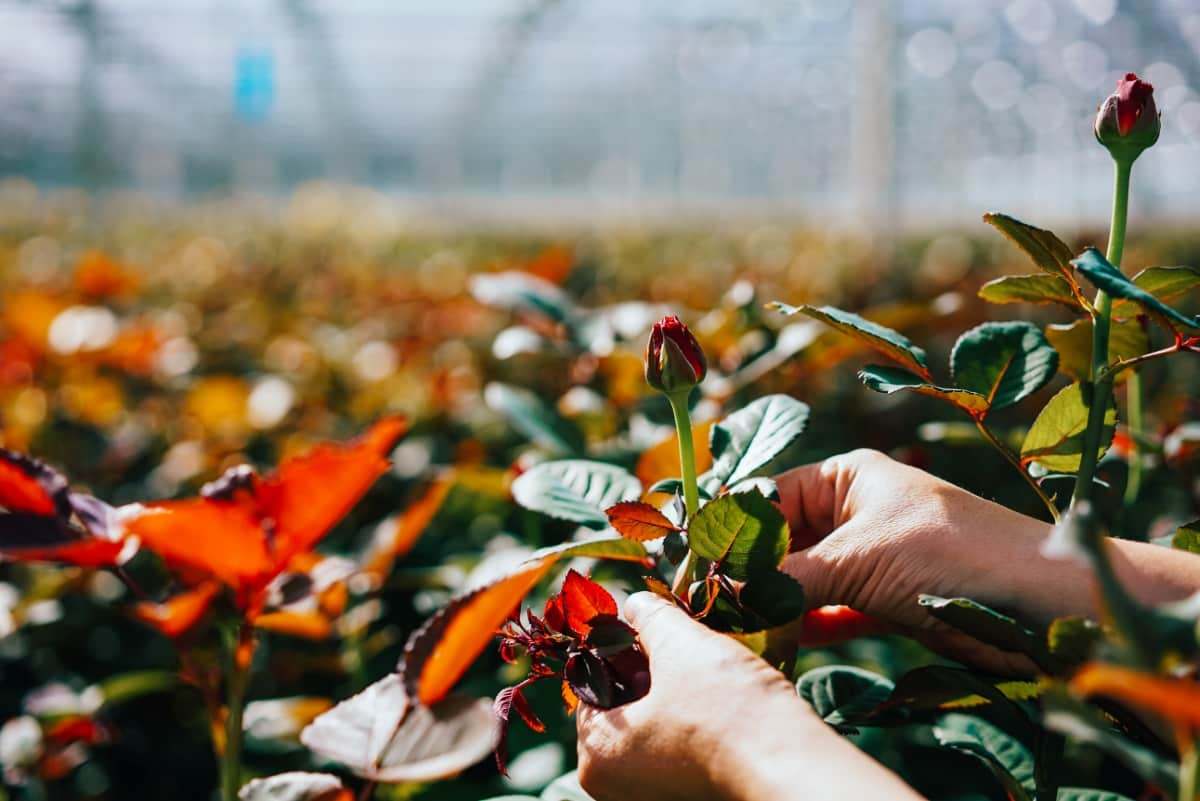The Dutch rose is a popular and beautiful flower that symbolizes love all over the world. It is one of the most demanded cut flowers in the national and international markets. Dutch rose cultivation is mostly done in polyhouses, where the climate is controlled, and the quality is improved.

However, some farmers also grow Dutch roses in open fields, where the cost of production is lower, but the yield and quality are affected by environmental factors. In this blog post, we will compare the advantages and disadvantages of Dutch rose cultivation in the 1-acre open field and polyhouse settings.
Dutch Rose Cultivation in 1-acre Open Field and Polyhouse
Commercial Dutch Rose Varieties List
Dutch roses come in various varieties, including First Red, Avalanche, Gold Strike, Tineke, and Taj Mahal. First, Red is a bright red variety with long stems and large buds, offering good vase life and disease resistance. Avalanche is a white variety with creamy edges and greenish centers, suitable for various occasions and seasons.
Gold Strike is a yellow variety with golden petals and greenish centers, ideal for weddings and celebrations. Tineke is a white variety with light pink edges and greenish centers, suitable for any occasion. Taj Mahal is a premium peach variety with orange hues and yellow centers, commanded by high market prices.
Propagation Method of Dutch Rose
Dutch rose propagation involves stem cuttings or tissue culture. Stem cuttings are taken from healthy plants and planted in a nursery bed or polybags. They are watered regularly and kept under shade until roots develop. Tissue culture produces plants from small pieces of plant tissue in a sterile laboratory environment. Plantlets are grown in test tubes or flasks and then hardened off before planting.
Dutch Rose Cultivation in Open Field
Dutch rose cultivation in open fields requires well-drained and porous soil with a pH of 6.5 to 7. The soil should be sterilized before planting to avoid soil-borne diseases. The beds should be raised to 45 cm height and 90 cm width, with a 45 cm pathway between them. The beds should be filled with organic manure, gravel sand, and soil in appropriate proportions. The planting material should be healthy and disease-free stem cuttings or tissue culture plantlets.
The planting should be done in rows at a spacing between 30 cm x 30 cm or 45 cm x 45 cm, depending on the variety. The planting depth should be 10 to 15 cm. The irrigation should be done as per the soil moisture and climatic conditions. Drip irrigation is preferred as it saves water and reduces weed growth. The water quality should have an EC of less than one dS/m, pH of 5.5 to 7, SAR of less than 10, RSC of less than 2.5 meq/l, and TDS of less than 1000 ppm.
The fertilization should be done according to the soil test results and crop requirements. Generally, a dose of 150 kg N, 75 kg P2O5, and 75 kg K2O per acre per year is recommended for Dutch rose cultivation in open fields. The fertilizers should be applied in split doses through drip irrigation or as foliar sprays. The intercultural practices include weeding, hoeing, mulching, pruning, disbudding, bending, deleafing, pest and disease management, etc. Weeding should be done manually or mechanically to keep the beds weed-free.
Hoeing should be done to aerate the soil and improve water infiltration. Mulching should be done with organic materials like straw, sawdust, etc., to conserve soil moisture and prevent weed growth. Pruning should be done to remove dead, diseased, or damaged branches, maintain the desired plant shape and size.
In case you missed it: 10 Dutch Rose Farming Success Stories in India: A Horticulture Profitable Business

Disbudding should be done to remove the side buds and leave only one terminal bud per stem to get bigger flowers. Bending should be done to bend the stems horizontally at a height of 40 to 50 cm from the ground level to induce more flowering shoots from the axils of leaves. Deleafing is a process to improve air circulation and reduce disease incidence in plants.
Integrated pest management practices, including cultural, mechanical, biological, and chemical methods, are used for pest and disease management. Harvesting occurs when buds are half open or show color, depending on market demand. Stems are cut at 40-60 cm lengths, and flowers are graded based on length, bud size, color, and quality. Bunches are packed and stored in a cool, dark place at 2 to 4°C and 90 to 95% relative humidity.
Yield of Dutch Rose Per Acre in Open Field
The yield of Dutch roses in open fields depends on various factors such as variety, planting density, climatic conditions, cultural practices, and pest and disease incidence. An average yield of 8–10 lakh flowers per acre per year can be achieved. The cost of production in a 1-acre open field varies depending on region, variety, and market price. An approximate estimation is Rs. 10,000 for land preparation, Rs. 11,000 for planting material, Rs. 50,000 for irrigation, Rs. 30,000 for fertilizers, Rs. 20,000 for pesticides, and Rs. 23,80,000 for profit.
Dutch Rose Cultivation in Polyhouse
Dutch rose cultivation in polyhouse requires a naturally ventilated polyhouse structure with a polyethylene covering material. The polyhouse should have a proper orientation, design, and management to provide optimum light, temperature, humidity, and ventilation for the plants. The soil condition and sterilization in polyhouses are similar to that of open field cultivation.
However, some growers prefer to use artificial growing media like coco peat, rockwool, pumice, etc., instead of soil for better root growth and water-holding capacity. The soil bed preparation in polyhouse is also similar to that of open field cultivation. However, some growers use raised benches or troughs instead of beds for better drainage and aeration.
The planting in polyhouse is done with healthy and disease-free stem cuttings or tissue culture plantlets at a spacing of 15 cm x 15 cm or 20 cm x 20 cm, depending on the variety. The planting depth is 5 to 10 cm. 1 acre (4046.86 square meters), and you can plant about 28,328 to 56,657 Dutch rose plants. The irrigation in polyhouse is done through drip irrigation as per the soil moisture and climatic conditions.
The water quality should have an EC of less than 0.75 dS/m, pH of 5.5 to 6.5, SAR of less than 5, a RSC of less than one meq/l, and TDS of less than 500 ppm. The fertilization in polyhouses is done according to the soil test results and crop requirements. Generally, a dose of 200 kg N, 100 kg P2O5, and 100 kg K2O per acre per year is recommended for Dutch rose cultivation in polyhouses. The fertilizers should be applied in split doses through drip irrigation or as foliar sprays. Polyhouse cultivation involves intercultural practices similar to open-field cultivation, with modifications.
In case you missed it: Different Types of Rose Propagation Methods: Exploring Various Rose Propagation Techniques

Pruning, bending, and deleafing should be done more frequently and gently to maintain the desired plant height and number of shoots. Pest and disease management should be done using IPM practices with a focus on biological and cultural methods. Harvesting should occur when buds are fully open or show color, and stems should be cut at 60-80 cm lengths. Flowers should be graded based on stem length, bud size, color, and quality, packed in bunches, and stored in a cool, dark place.
Yield of Dutch Rose Per Acre in Polyhouse
An average yield of 225 to 350 stems per square meter can be expected from the polyhouse cultivation of Dutch roses. This means that in one acre, you can harvest about 9 lakh to 14 lakh stems of Dutch roses per year.
Polyhouse Costs and Profit in 1-acre Dutch Rose Cultivation
The cost of setting up a polyhouse for Dutch rose cultivation varies depending on the type, size, design, and quality of the structure and materials. An estimated cost is around Rs. 30-40 lakh per acre for a naturally ventilated polyhouse with drip irrigation, fertigation, shade net, insect net, and other accessories.
The operational cost includes planting material, fertilizers, pesticides, labor, electricity, water, maintenance, and marketing. The profit from polyhouse cultivation depends on the yield and price of the flowers, which fluctuate according to season, demand, and supply. An average yield of 11.5 lakh stems per acre per year and an average price of Rs. 5 per stem could result in a gross income of around Rs. 57.5 lakh per acre per year.
In case you missed it: How to Use Neem Oil on Rose Plants: Best Natural Way to Eradicate Rose Pests

Conclusion
A comparative analysis reveals that Dutch rose cultivation in a polyhouse offers greater control over environmental conditions, leading to higher yields and quality compared to open-field cultivation. However, this comes with higher initial setup and operational costs. The choice between the two depends on the grower’s resources and market goals.
- Feed Your Flock for Less: Top 10 Tips to Save on Chicken Feed
- Ultimate Guide to Ossabaw Island Hog: Breeding, Raising, Diet, and Care
- Hatching Answers: The Top 10 Reasons Your Chickens Aren’t Laying Eggs
- Eggs and Economics: Breaking Down the Cost of Raising Backyard Chickens
- Defend Your Greens: Proven Methods to Keep Iguanas Out of Your Garden
- Ultimate Guide to Cinnamon Queen Chicken: A Comprehensive Guide for Beginners
- Ultimate Guide to California Tan Chicken: Breeding, Raising, Diet, Egg-Production and Care
- Ultimate Guide to Marsh Daisy Chicken: Breeding, Raising, Diet, and Care
- 10 Types of Chicken Farming Businesses You Can Start for Profits